Bromeliaceae
| Bromeliaceae | |
|---|---|
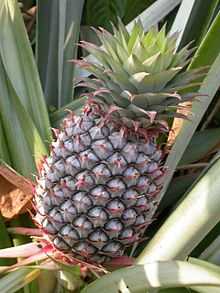 | |
| Pineapple, a bromeliad | |
| Scientific classification | |
| Kingdom: | Plantae |
| (unranked): | Angiosperms |
| (unranked): | Monocots |
| (unranked): | Commelinids |
| Order: | Poales |
| Family: | Bromeliaceae Juss.[1] |
| Subfamiles | |
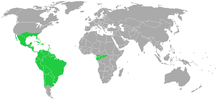 | |
The Bromeliaceae (the bromeliads) are a family of monocot flowering plants of around 3,170 species native mainly to the tropical Americas, with a few species found in the American subtropics and one in tropical west Africa, Pitcairnia feliciana.[2] They are among the basal families within the Poales and are unique because they are the only family within the order that has septal nectaries and inferior ovaries.[3] These inferior ovaries characterize the Bromelioideae, a subfamily of the Bromeliaceae.[4] The family includes both epiphytes, such as Spanish moss (Tillandsia usneoides), and terrestrial species, such as the pineapple (Ananas comosus). Many bromeliads are able to store water in a structure formed by their tightly-overlapping leaf bases. However, the family is diverse enough to include the tank bromeliads, grey-leaved epiphyte Tillandsia species that gather water only from leaf structures called trichomes, and a large number of desert-dwelling succulents.
The largest bromeliad is Puya raimondii, which reaches 3–4 m tall in vegetative growth with a flower spike 9–10 m tall, and the smallest is Spanish moss.
Description
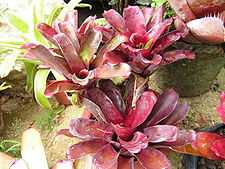
Bromeliads are plants that are adapted to a number of climates. Foliage takes different shapes, from needle-thin to broad and flat, symmetrical to irregular, spiky to soft. The foliage, which usually grows in a rosette, is widely patterned and colored. Leaf colors range from maroon, through shades of green, to gold. Varieties may have leaves with red, yellow, white and cream variations. Others may be spotted with purple, red, or cream, while others have different colors on the tops and bottoms of the leaves.
The inflorescences produced by bromeliads are also regarded as considerably more diverse than any other plant family. Some flower spikes may reach 10 meters tall, while others only measure 2–3 mm across. Upright stalks may be branched or simple with spikes retaining their color from two weeks up to 12 months, depending on species. In some species, the flower remains unseen, growing deep in the base of the plants.
Root systems vary according to plant type. Terrestrial bromeliad species have complex root systems that gather water and nutrients, while epiphytic bromeliads only grow hard, wiry roots to attach themselves to trees and rocks.

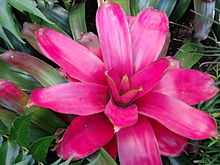
Some bromeliads are faintly scented, while others are heavily perfumed. Blooms from the species Tillandsia cyanea resemble the smell of clove spice.
One study found 175,000 bromeliads per hectare (2.5 acres) in one forest; that many bromeliads can sequester 50,000 liters (more than 13,000 gallons) of water.[5]
A wide variety of organisms takes advantage of the pools of water trapped by bromeliads. A study of 209 plants from the Ecuadorian lowlands identified 11,219 animals, representing more than 300 distinct species, many of which are found only on bromeliads. Examples include some species of ostracods, small salamanders about 2.5 cm (1 in) in length, and tree frogs. Jamaican bromeliads are home to Metopaulias depressus, a reddish-brown crab 2 cm (0.75 inch) across, which has evolved social behavior to protect its young from predation by Diceratobasis macrogaster, a species of damselfly whose larvae live in bromeliads. Some bromeliads even form homes for other species of bromeliads.[5]
.jpg)
Distribution
Plants in the Bromeliaceae are widely represented in their natural climates across the Americas. One species can be found in Africa. They can be found at altitudes from sea level to 4200 meters, from rainforests to deserts. Approximately half the species are epiphytes, some are lithophytes, and some are terrestrial. Accordingly, these plants can be found in the Andean highlands, from northern Chile to Colombia, in the Sechura Desert of coastal Peru, in the cloud forests of Central and South America, in southern United States from southern Virginia to Florida to Texas, and in far southern Arizona.
Evolution
Bromeliads are among the more recent plant groups to have emerged. The greatest number of primitive species resides in the Andean highlands of South America, where they originated in the tepuis of the Guyana Shield.[6] The most basal genus, Brocchinia, is endemic to these tepuis, and is placed as the sister group to the remaining genera in the family.[7] The west African species Pitcairnia feliciana is the only bromeliad not endemic to the Americas, and is thought to have reached Africa via long-distance dispersal about 12 million years ago.[6]
Adaptations
Bromeliads are able to live in a vast array of environmental conditions due to their many adaptations. Trichomes, in the form of scales or hairs, allow bromeliads to capture water in cloud forests and help to reflect sunlight in desert environments.[8] Some bromeliads have also developed an adaptation known as the tank habit, which involves them forming a tightly bound structure with their leaves that helps to capture water and nutrients in the absence of a well-developed root system.[8] Bromeliads also use crassulacean acid metabolism (CAM) photosynthesis to create sugars. This adaptation allows bromeliads in hot or dry climates to open their stomates at night rather than during the day, which reduces water loss.[9]
Classification
The family Bromeliaceae is currently placed in the order Poales.
Subfamilies
The family Bromeliaceae is organized into three subfamilies:
- Bromelioideae (32 genera, 861 species)
- Pitcairnioideae (16 genera, 1030 species)
- Tillandsioideae (9 genera, 1277 species)
Genera
Gallery
-

Tillandsia usneoides hanging from branches
-
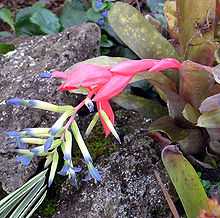
The flower of a Billbergia sp.
-

Puya alpestris
-

Flower close-up
-

A bromeliad
-

Tillandsia airplants mounted on the bark of a cork oak
Cultivation and uses
Humans have been using bromeliads for thousands of years. The Incas, Aztecs, Maya and others used them for food, protection, fiber and ceremony, just as they are still used today. European interest began when Spanish conquistadors returned with pineapple, which became so popular as an exotic food that the image of the pineapple was adapted into European art and sculpture. In 1776, the species Guzmania lingulata was introduced to Europe, causing a sensation among gardeners unfamiliar with such a plant. In 1828, Aechmea fasciata was brought to Europe, followed by Vriesea splendens in 1840. These transplants were so successful, they are still among the most widely grown bromeliad varieties.
In the 19th century, breeders in Belgium, France and the Netherlands started hybridizing plants for wholesale trade. Many exotic varieties were produced until World War I, which halted breeding programs and led to the loss of some species. The plants experienced a resurgence of popularity after World War II. Since then, Dutch, Belgian and North American nurseries have largely expanded bromeliad production.
Only one bromeliad, the pineapple (Ananas comosus), is a commercially important food crop. Bromelain, a common ingredient in meat tenderizer, is extracted from pineapple stems. Many other bromeliads are popular ornamental plants, grown as both garden and houseplants.
Collectors
Édouard André was a French collector/explorer whose many discoveries of bromeliads in the Cordilleras of South America would be influential on horticulturists to follow. He served as a source of inspiration to 20th-century collectors, in particular Mulford B. Foster and Lyman Smith of the United States and Werner Rauh of Germany.[10]
See also
References
- ↑ Angiosperm Phylogeny Group (2009), "An update of the Angiosperm Phylogeny Group classification for the orders and families of flowering plants: APG III", Botanical Journal of the Linnean Society 161 (2): 105–121, doi:10.1111/j.1095-8339.2009.00996.x, retrieved 2010-12-10
- ↑ Mabberley, D.J. (1997). The Plant Book. Cambridge: Cambridge University Press.
- ↑ Judd, Walter S. Plant systematics a phylogenetic approach. 3rd ed. Sunderland, MA: Sinauer Associates, Inc., 2007.
- ↑ Sajo, M. G. "Floral anatomy of Bromeliaceae, with particular reference to the epigyny and septal nectaries in commelinid monocots." Plant Systematics and Evolution 247 (2004): 215-31.
- ↑ 5.0 5.1 "Pineapple Dreams", The Wild Side, Olivia Judson, The New York Times, March 18, 2008
- ↑ 6.0 6.1 Givnish, Thomas J., Kendra C. Millam, Timothy M. Evans, Jocelyn C. Hall, J. C. Pires, Paul E. Berry, and Kenneth J. Sytsma. "Ancient vicariance or recent long-distance dispersal? Inferences about phylogeny and South American-African disjunctions in Raptaceae and Bromeliaceae based on ndhf sequence data." International Journal of Plant Science 165.4 (2004): 35-54.
- ↑ Barfuss, Michael H., Rosabelle Samuel, Walter Till, and Todd F. Stuessy. "Phylogenetic relationships in subfamily Tillandsioideae (Bromeliaceae) based on DNA sequence data from seven plastid regions." American Journal of Botany 92.2 (2005): 337-51.
- ↑ 8.0 8.1 Schulte, Katharina, Michael H. Barfuss, and Georg Zizka. "Phylogeny of Bromelioideae (Bromeliaceae) inferred from nuclear plastid DNA loci reveals the evolution of the tank habit within the subfamily." Molecular Phylogenetics and Evolution 51 (2009): 327-39.
- ↑ Rex, Martina, Kerstin Patzolt, Katharina Schulte, Georg Zizka, Roberto Vasquez, Pierre L. Ibisch, and Kurt Weising. "AFLP analysis of genetic relationships in the genus Fosterella L.B. Smith (Pitcairnioideae, Bromeliaceae)." Genome 50 (2007): 90-105.
- ↑ André, Édouard François. "Bromeliaceae Andreanae. Description et histoire des Bromeliacees recoltees dans La Colombie, L'Ecuador et Le Venezuela". Paris: Librairie Agricole; G. Masson, 1889
External links
| Wikimedia Commons has media related to Bromeliaceae. |
| Wikispecies has information related to: Bromeliaceae |
- The Brom-L Bromeliad Gallery The Photo Gallery of the (Virtual) World Wide Web Bromeliad Society
- The New Bromeliad Taxon List A constantly updated list of current Bromeliad names and synonyms.
- Palm trees, small palms, Cycads, Bromeliads and tropical plants Photos of Bromeliads and associated flora, with information on habitat and cultivation.
- Luther, H. E. (2002) An Alphabetical List of Bromeliad Binomials The Marie Selby Botanical Gardens, Sarasota, Florida. Published by The Bromeliad Society International.
- Luther, H. E. (2008) An Alphabetical List of Bromeliad Binomials, Eleventh Edition The Marie Selby Botanical Gardens, Sarasota, Florida. Published by The Bromeliad Society International.
- Bromeliaceae in L. Watson and M.J. Dallwitz (1992 onwards). The families of flowering plants: descriptions, illustrations, identification, information retrieval. Published by Delta-intkey (2002-06-18)
- The Bromeliad Society International
- Bromeliad care information
- Puya raimondii photos
- The World Botanical Gardens
- Bromeliads of Chile in Chileflora

